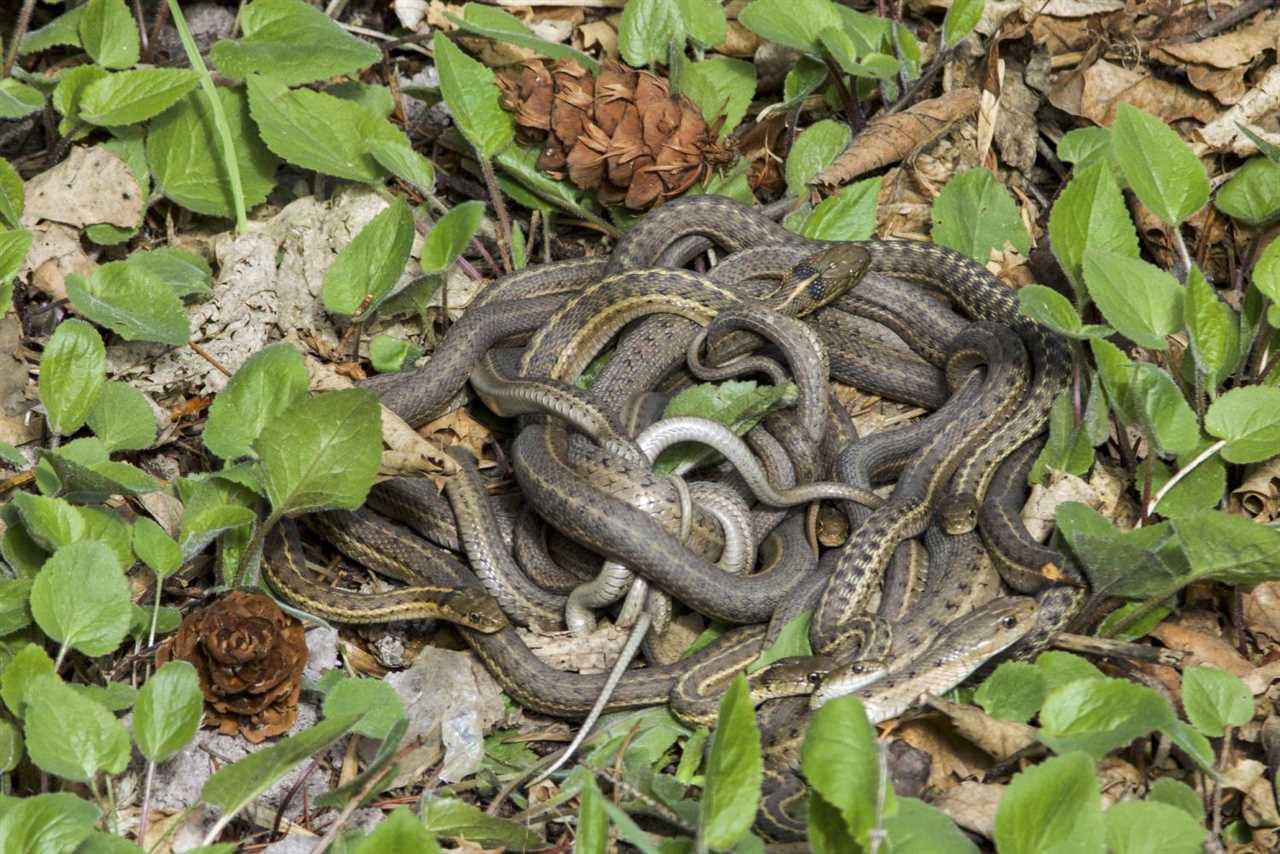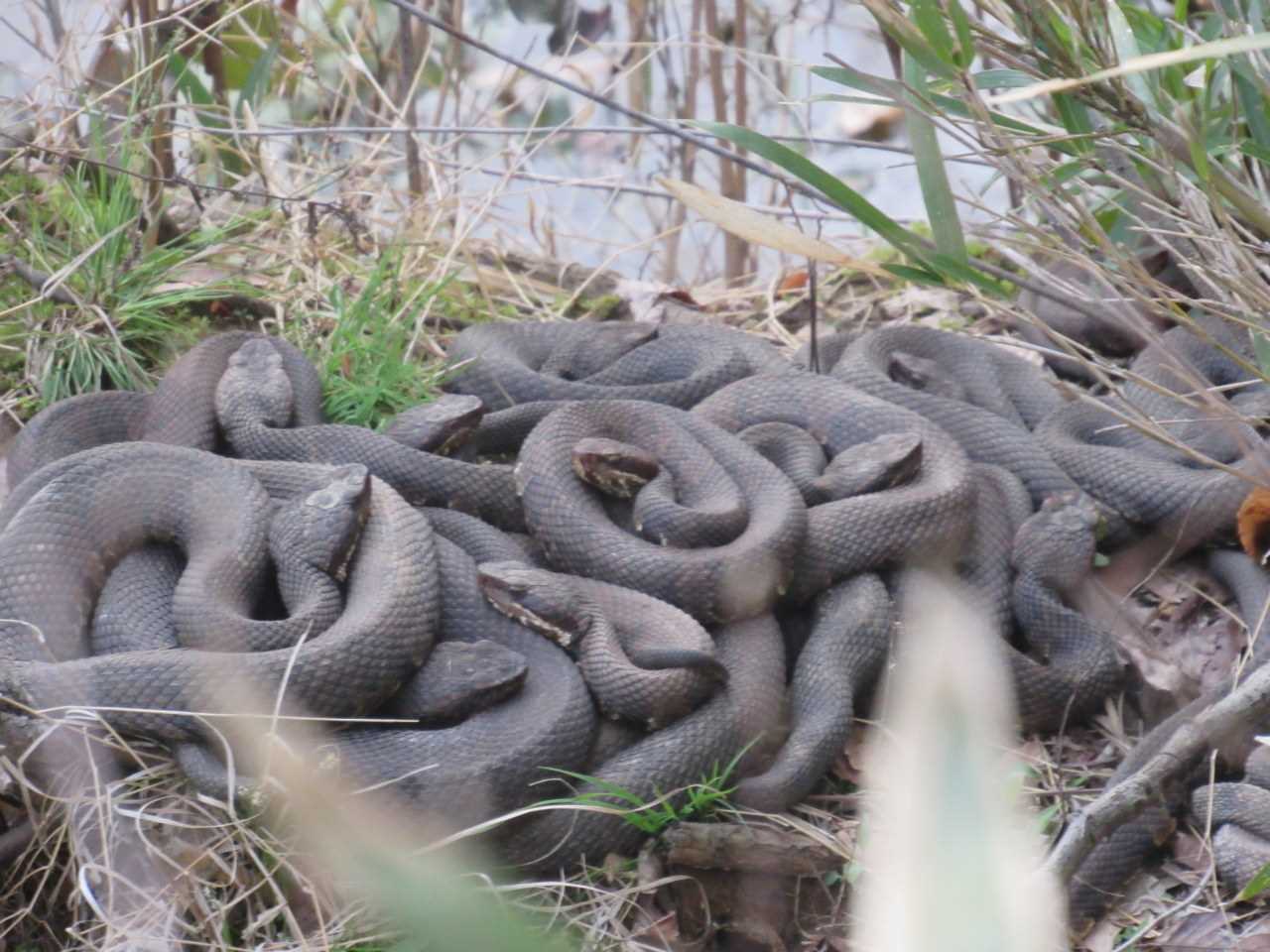
One of the most distinctive features of the water moccasin is its reputation as a venomous snake. Armed with potent venom, it poses a significant threat to potential predators and prey alike. Its venomous bite can be deadly, making it a creature to be approached with caution and respect.
The water moccasin’s adaptability is truly remarkable. It can thrive in both freshwater and brackish water habitats, making it a versatile predator. Its diet consists of a variety of prey, including fish, frogs, small mammals, and even other snakes. Equipped with sharp fangs and a keen sense of smell, the water moccasin is a formidable predator in its ecosystem.
Despite its reputation, the water moccasin plays a crucial role in maintaining the delicate balance of its wetland habitat. As an apex predator, it helps control the population of smaller species, preventing overpopulation and promoting biodiversity. Furthermore, its existence serves as an indicator of the overall health of the ecosystem.
In our comprehensive Ball of Water Moccasins Guide, we will delve into the intriguing world of water moccasins, exploring their behavior, habitat, and conservation status. Through captivating stories and stunning visuals, we will unravel the mysteries of these remarkable reptiles, shedding light on their importance and the need to protect their fragile environment.
Discover the Fascinating World of Water Moccasins
Appearance
Habitat
The preferred habitat of water moccasins is wetlands, including swamps, marshes, and slow-moving bodies of water such as creeks, rivers, and lakes. These snakes are well-adapted to aquatic environments and are often found near the water’s edge. They are excellent swimmers and can even float on the surface of the water.
Behavior
Water moccasins are generally solitary creatures and prefer to avoid human contact. They are mainly active during the day, but can also be active at night, especially during warmer months. When threatened, they may open their mouth wide to display the white lining, which is why they are called cottonmouth snakes.
Diet
Reproduction
The reproduction process of water moccasins begins with courtship rituals, where males compete for the attention of females. After mating, the female will undergo a gestation period of approximately three months. She will then give live birth to a litter of 2-16 young snakes. The newborn snakes are independent from birth and must quickly learn to fend for themselves.
Exploring the Habitat of Water Moccasins
The Marsh and Swamp Environment
Water moccasins are well adapted to their unique habitat in marshes and swamps. These watery environments provide them with the perfect conditions for survival. The marshes and swamps are characterized by their dense vegetation, muddy terrain, and abundant water sources such as ponds, lakes, and sluggish streams.
Abundant Water Sources: The presence of water bodies in their habitat ensures a reliable supply of prey such as fish, frogs, and small mammals. The water moccasins are excellent swimmers and can move through the water with ease, making it easier for them to catch their prey.
Dense Vegetation: The marshes and swamps are covered with a variety of plant species, including water-lilies, cattails, and other aquatic plants. This dense vegetation provides the water moccasins with ample hiding spots and camouflage, making it easier for them to ambush their prey or avoid predators.
Muddy Terrain: The muddy terrain is conducive to the water moccasins’ lifestyle as it allows them to burrow and create hiding spots. They can often be found lying in wait near the water’s edge, partially submerged in the muddy banks, ready to strike at unsuspecting prey.
Interaction with Other Species
Water moccasins have a significant impact on the ecosystem of the marshes and swamps they inhabit. They play a vital role in controlling the populations of their prey species, such as fish and amphibians. These snakes also serve as a source of food for larger predators like birds of prey and other carnivorous mammals.
Predator-Prey Interactions: The water moccasins are skilled hunters and use their venomous bite to immobilize and kill their prey. Their presence helps maintain a balanced food chain in the marshes and swamps, preventing any one species from becoming too dominant.
Competition for Resources: Water moccasins may also compete with other reptile species for food and suitable nesting sites. While they are well adapted to their habitat, competition for limited resources can be fierce, leading to intense territorial disputes among individuals.
The “Ball” of Water Moccasins

One of the most striking features of water moccasins is their robust and muscular build. These snakes have a stout body and a distinctive triangular-shaped head, which helps distinguish them from non-venomous snake species. When threatened or disturbed, water moccasins may raise their heads and coil their bodies into a tight ball, giving them their unique “ball” appearance.
The Moccasins’ Coloration
The coloration of water moccasins serves as another key characteristic for identification. These snakes usually have dark brown to black bodies, which are often accompanied by a series of dark crossbands or blotches along their backs. The color patterns can vary, but the overall effect is an animal that blends seamlessly into the murky, swampy surroundings.
Distinctive Facial Features
Furthermore, water moccasins possess vertically slit pupils, similar to those of cats, which are another distinguishing characteristic. This adaptation enhances their ability to perceive movement and enhances their overall hunting success.
Conclusion
The distinctive appearance of water moccasins makes them easily recognizable among the snake species found in swampy marshes. From their muscular build to their dark coloration and distinctive facial features, every aspect of their appearance is an adaptation that aids in their survival and hunting strategies.
Remember to exercise caution and keep a safe distance if you encounter a water moccasin in its natural habitat. Observe and appreciate these remarkable creatures from a respectful distance while ensuring your own safety.
- Nocturnal Nature: Water moccasins are primarily active during the night, making them more challenging to observe during daylight hours. Their preference for the cover of darkness allows them to hunt for prey more effectively and avoid potential predators.
- Semi-Aquatic Lifestyle: These snakes have adapted to live in and around bodies of water, such as swamps, marshes, and ponds. They are excellent swimmers and can often be seen gliding through the water with their long, slender bodies. This aquatic habitat is where they find their preferred prey, such as small fish and amphibians.
- Territoriality: Water moccasins tend to be territorial creatures and will fiercely defend their chosen area of the swamp or marsh. They may exhibit aggressive behaviors towards both intruding snakes and other animals that come too close to their territory.
- Temperature Regulation: Like all reptiles, water moccasins are ectothermic, meaning they rely on external sources of heat to regulate their body temperature. You may find them basking on logs or rocks near the water’s edge, soaking up the sun’s warmth. This behavior helps them maintain their metabolism and overall health.
Discover the Diet of Water Moccasins
The diet of water moccasins mainly consists of small mammals, fish, amphibians, and birds. They are opportunistic predators and will feed on any suitable prey that comes within their striking range. Their common prey includes mice, rats, voles, frogs, lizards, small turtles, and even small birds. Water moccasins are also known to consume carrion on occasion.
Hunting Techniques
Water moccasins are capable hunters and employ various strategies to catch their prey. One common technique is ambush predation. They will lie in wait, partially submerged in the water or hidden in vegetation, patiently waiting for their prey to come close. When an opportunity presents itself, they strike with lightning speed, injecting venom into their victim and quickly swallowing it.
Another hunting technique used by water moccasins is active foraging. They are proficient swimmers and can move gracefully through the water in search of prey. They will often use their keen sense of smell to track down potential meals, following the scent trail of their prey underwater. Once they locate their target, they strike and subdue it before swallowing it whole.
Adaptations for Feeding
Water moccasins have several adaptations that aid in their feeding process. First and foremost is their venom, which they use to incapacitate their prey. Their venom is highly toxic and can quickly immobilize small animals, making them easier to subdue and consume. They have hollow fangs located in the front of their mouth, which they use to inject venom into their prey.
In addition to their venomous bite, water moccasins also possess a specialized jaw structure that allows them to swallow prey items larger than their head. Their lower jaws are highly flexible and can stretch to accommodate larger prey. This adaptation enables them to consume prey more efficiently and reduces the risk of injury while swallowing.
Water moccasins play an important role in the ecosystem as top predators. They help regulate populations of small mammals and other prey species, contributing to the overall balance of their habitat. While they may evoke fear and caution in humans, water moccasins are fascinating creatures with unique adaptations for survival and feeding.
Uncover the Reproduction Process of Water Moccasins
Reproductive Behavior
Water moccasins have a unique reproductive behavior that distinguishes them from other snake species. They exhibit a form of reproduction called ovoviviparity, which means that they give birth to live young instead of laying eggs.
Once the dominant male secures a mate, the pair engages in a courtship ritual that involves rubbing their bodies against each other. This behavior stimulates the female to release her eggs, which are then fertilized by the male. The eggs develop and hatch inside the female’s body, and she eventually gives birth to fully-formed, live young.
Growth and Development
After birth, water moccasin young are independent. They have fully functional venom glands and are capable of hunting and defending themselves from a young age. The newborn snakes are usually around 8 to 10 inches in length and possess the characteristic pattern of dark bands on a lighter background, similar to the adult moccasins.
Conservation Implications
The reproduction process of water moccasins is undeniably fascinating, but it also has important implications for conservation efforts. Due to their unique reproductive behavior, water moccasins have relatively low reproductive rates compared to other snake species. This means that any decline in their population can have significant impacts on their overall numbers.
Stay Safe: Tips for Avoiding Water Moccasin Bites
1. Be aware of your surroundings:
2. Avoid tall grass and dense vegetation:
3. Stay away from water sources:
4. Wear appropriate footwear:
5. Do not disturb or provoke the snakes:
6. Educate yourself:
7. Seek medical attention if bitten:
If, despite your best efforts, you are unfortunate enough to be bitten by a water moccasin, it is crucial to seek immediate medical attention. Water moccasin bites can be very painful and may cause serious symptoms, such as swelling, tissue damage, and even systemic effects. Do not attempt to treat the bite yourself, as proper medical care is essential.
| Important Note: |
|---|
|
Remember, water moccasins are venomous snakes and should be treated with caution. If you encounter a water moccasin, give it a wide berth and allow it to move away on its own. With proper awareness and precautions, you can stay safe and avoid potential encounters with these fascinating yet dangerous snakes. |

I’m Lena Adams—a product of an unconventional upbringing in the African wilderness. My father, a daring explorer of African wildlife, sparked my fascination with reptiles, a passion that intertwined with the tragic loss of my mother during an expedition, leaving an indelible mark on my life. Driven to understand the creatures that captivated my parents, I embarked on my journey, sharing insights about reptiles, frogs, and lizards on my website. Through my explorations and conservation efforts, I honour my family’s legacy while seeking connections—to the creatures, nature, and the mother whose presence I yearn to understand.
